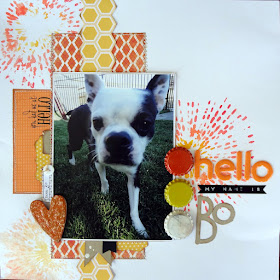Good morning friends! Today I wanted to share with you more about a product that I use all the time on my scrapbooking pages : Watercolour Paints. As I mentioned in Part 1, I am not an expert on watercolour paints in the traditional sense! But I can tell you what works for me and how I achieve the techniques you may have seen on my pages or cards. Ready?
To begin, let me share with you some of the products and tools I use for this technique:
1. I chose some good quality watercolours with lots of shade options. I recently purchase some new colours at Two Scrapbook Friends
2. I have a small selection of very reasonably priced paint brushes in different bristle type. For this project I like a square ended brush.
3. Paper towels for blotting and to act as an absorbent mat under my art work.
4. A basin of water (change this often as your light colours will show the taint of blackened paint water)
5. For this demonstration I have included some templates as well. Balzer designs creates them in many patterns and sizes. Two Scrapbook Friends had several options in stock.
Since my last tutorial, a few of my scrappy friends mentioned that they were not as pleased with the results they achieved..we finally discovered it comes down to the next topic (and the most important!): QUALITY of the paints. I cannot stress this enough. Don't look to your child's craft cupboard paints for a great watercolour experience! In fact, when acquiring paint and brushes I tend to look for quality like I do any other scrapbooking supply I am going to put into my scrapbooks. The colours from good paint are truer, allowing you to better blend colours to match a patterned paper or predict their shade with more accuracy. The brushes that are good quality will not shed their bristles in the middle of your design and will not separate while in use. Ask at Two Scrapbook Friends for information on good quality paints and brushes to order
Also, I would like to remind you that Watercolour can be made more or less intense by adding more or less water. I recommend experimenting before you begin; especially if you are concerned about the end result. If you are a go-with-the-watercolour-flow kinda gal, the have it and art will out! The latter is my path these days and sometimes you can be surprised.
All of my techniques require you to have a protected work surface or area away from items that could become ruined in the process. I cannot stress this enough. Watercolour paint does not come off photos even though it can be wiped off surfaces if you act quickly. Follow manufacturer instructions for care and safety.
Now! On to the fun part: let's talk about using watercolours with stencils!
In this layout,I created featuring my very handsome doggy, Bo-Bo, I laid out the page before I decided where to place my template. In fact the painting was one of the final stages of my design process.
Once I had decided where I needed the paint I removed all the elements to a safe location and set up my craft area for the watercolour paint.
Step 1:
Lay out your paper towel base and place your card stock on top. Then place the template in position.
Step 2:
I like to use fairly DRY water colour combinations when working with templates since the we don't want the watercolour to flow UNDER the template and obscure the design. To do this I add a minimal amount of water and do a test on a scrap piece of paper the same shade as my background. For this template design, I began with my lightest shade (opposite to the splatter technique).
Step 3:
I prefer to hold down the template with my hand firmly. I have seen the use of painters tape if you are uncertain or want to be sure the design doesn't shift accidentally. Using your brush and the shade you have chosen, I began 'dabbing' or 'stippling' the paint in a round motion in the CENTRE of the template. I added a bit of water and paint to my brush and continued until it was the shade I desired.
Step 4:
When I have added all the shades I need for my design, I then lift the template up as VERTICALLY as I could without moving it. (if you have chosen to use painters tape, leave it adhered until the design is dry. DO NOT use your heat tool on your plastic template! It will melt.) You will notice the template is damp and covered with paint. I then use more paper towel to wipe off the excess from BOTH sides. You can use regular dish soap to wash your templates between uses.
Step 5:
If you dislike dry time ( and who doesn't?) then I use my heat tool to gently dry the design and complete my layout as planned.
Here's that layout I made of my darling BoBo showing this technique.
I hope you have enjoyed this journey of discovery and maybe learned something new. Until next time, keep doing what you love,
Christa








Great technique and I love the final look of your page!
ReplyDeleteLoved the finished effect on your page......great tips and ideas too.
ReplyDeleteOk, your Bo is adorable, I once had a Zeke a long time ago. :) Love this technique, Christa. :) Great tutorial and a fabulous layout!
ReplyDeletelove this look, thanks for the 'how to'!
ReplyDeleteYour tutorial is so helpful! I always wondered how you got such amazing designs with your paints!
ReplyDeleteJoanne xo